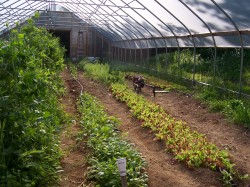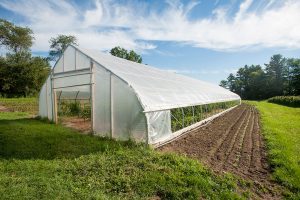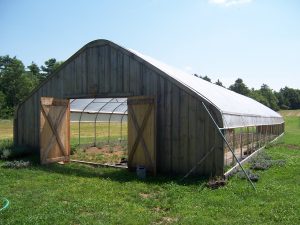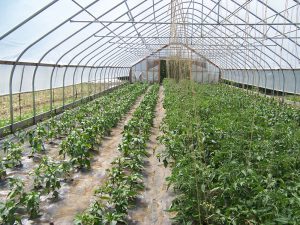Bulletin #1054, Why High Tunnel Growing in Maine Might Be a Suitable Enterprise for Persons with Disabilities
Developed by Extension Professor, Richard Brzozowski and Extension Maine AgrAbility Coordinator Leilani Carlson, University of Maine.
Reviewed by Dave Fuller, Agriculture and Non-Timber Forest Products Professional, University of Maine Cooperative Extension; Mark Hutton, Vegetable Specialist, University of Maine Cooperative Extension, Vern Grubinger, Vegetable Specialist, University of Vermont Cooperative Extension, and Alexandru Surcica, Private Crop Consultant, Pennsylvania.
For information about UMaine Extension programs and resources, visit extension.umaine.edu.
Find more of our publications and books at extension.umaine.edu/publications/.
Table of Contents
- Disabilities and Farming
- Crop Production in a High Tunnel
- Considerations for Crop Production in a High Tunnel
- Pre-Construction High Tunnel Tasks and Considerations
- Other High Tunnel-Related Enterprising Opportunities
- Growing Area Layout Considerations
- Adaptive Tools and Technologies
- Conclusion
- Additional Resources
Disabilities and Farming
Having a disability or chronic illness might prevent or limit an individual from being employed by another person or company in a full-time or part-time basis. However, with appropriate planning, assistive tools, and safety measures in place, farming could be considered suitable for employment or self-employment to generate income (or partial income) for a person with limitations.
In farming, you can be your own boss. You can set your own schedule and plan necessary tasks around your abilities or limitations. Many tasks in farming can be performed with special tools, machinery, and adaptive technologies. Some tasks can be accomplished effectively through automation. These work modifications can save time, reduce physical stresses, and allow you to work more efficiently and safely. In addition, the daily act of farming can be therapeutic; the experiences allow you to be outdoors, growing and caring for animals or plants, be a good steward for the land and provide food for yourself, your family or others. Farming can also generate an income.
Crop Production in a High Tunnel
Having a disability may limit involvement with certain types and kinds of farming enterprises. However, some farming enterprises, such as high tunnels might present a good opportunity, with fewer physical and financial risks than others.
High tunnels (also known as hoop houses) are unheated greenhouse structures that can help farmers extend their growing season and increase the potential for profitability and productivity. Crop selections and production in a high tunnel can be designed to accommodate limitations.
This fact sheet is designed as an informational and exploratory tool to help you determine if high tunnel production might be a good fit for you. As you read this fact sheet, make notes or highlight the sections you see as important or that you want to learn more about.
Considerations for Crop Production in a High Tunnel
The high tunnel location, structure design, growing environment, layout, and crop selection can provide a suitable work setting for a farmer or farm worker with a disability or other physical limitation. High tunnels can be used to grow a wide array of vegetable crops, small fruit (berries), bedding plants, herbs, and/or flowers. As with any farming enterprise, reliable markets need to be identified and secured for your products or services as a first step before making monetary investments in high tunnel land preparations, construction, supplies, and capital.
In general, crop production in a high tunnel may be a good choice for you because:
- The high tunnel allows for some control of the climate. A person can work in the high tunnel almost at any time. Rain, snow or cold temperatures won’t necessarily keep you from working. Shade cloth can be used in summer months to reduce the inside temperature. Working in a high tunnel can be more comfortable than working outdoors exposed to the elements. The natural exchange of air or ventilating the facility can be accomplished with roll-up sides, via opening the doors on each end, or with fans.
- The work area can be easily compartmentalized. You can select to manage a specific amount of workspace per day inside the high tunnel. You can also control how you lay out the crops within the high tunnel. Trellising of some crops such as tomatoes and cucumbers can save space and make for easier harvest. By compartmentalizing your work area, the tasks you want to accomplish can be focused and sized to your abilities.
- If necessary, raised beds could be constructed inside the high tunnel allowing for ease of use in planting, tending, and harvesting crops. Construction and use of super-raised beds (those that are 24 to 30 inches in height) are also a possibility.
- The high tunnel allows you to extend the growing season from 8 to 10 months of the year. In many regions of the US, high tunnels are typically not used in December or January due to extremely cold temperatures and lack of natural light (shortness of day length).
- When using a high tunnel, there is a potential for increased economic benefit based on the extended growing season. This usually means better prices for specific crops and a greater economic return per square foot as high tunnel crops are grown more intensively.

In contrast, crop production in a high tunnel may not be a good fit for you because:
- The cost of a high tunnel can be prohibitive. The upfront cost consists of time and energy for land preparation, cost of the high tunnel structure, and labor to construct it. The Natural Resource Conservation Service (NRCS) may offer a cost-share program for the high tunnel structure. Check with NRCS at your local USDA Service Center.
- There are low-cost options for high tunnel construction that involve PVC pipe instead of metal.
- Low-Cost High Tunnel Construction (eXtension website)
- Constructing a Simple PVC High Tunnel (Metric Units) (HighTunnels.org website)
- With high tunnels, there is an increased need for good organization and management skills to produce crops 6 to 10 months of the year. Some individuals have a knack for management of high tunnels while others may struggle to be successful.
- The high tunnel must be maintained regularly for best results. This maintenance may include snow removal, shading, other tasks associated with a structure such as repair or reinforcement of the superstructure.
- Placing and replacing the plastic covering often takes pre-planning, organization and more than one person to complete successfully.
- You may be limited to the types of crops you are able to grow inside a high tunnel due to climate, water availability, soil type, markets and pests.
Pre-Construction High Tunnel Tasks and Considerations
Physical tasks are typically necessary for any successful farming enterprise. Below is a list of typical high tunnel-related chores. Depending on your specific crop and high tunnel set up, some chores may not apply. As you view the list, consider each chore and how it might be performed or if the chore is necessary for your situation. Look at a possible high tunnel enterprise critically, considering your own strengths and limitations.
Look at a possible high tunnel enterprise critically, considering your own strengths and limitations.
Pre-Construction / Pre-Purchase Considerations
Factors to consider before you build or buy a high tunnel:
- Develop a business plan: Within this plan, identify specific crops and markets to determine the feasibility of such an enterprise.
- Develop a plan for construction: When do you want the high tunnel in use? What is a reasonable timeline for construction?
- Site selection: Consider…
- Access to the high tunnel by mobility device or farm vehicles such as a truck, van, 4-wheeler or tractor (consider both construction and production aspects);
- Previous site or land use, was it used for equipment storage (possible leaked contaminants) or a domestic landfill?
- Existing soil type, depth, and quality;
- Slope of the land;
- Natural drainage from (and to) the high tunnel site; Do changes have to be made for proper drainage?
- Orientation of high tunnel to the sun and prevailing winds through every season of the year.
- Availability of water and electricity to the high tunnel is important: Consider the seasonal source and volume of water, and the estimated cost for installing utilities (if necessary).
- Identify the appropriate source(s) to purchase the high tunnel kit: Is the price influenced by the time of year?
- Identify adequate funds or obtain a loan for this enterprise, if necessary.
High Tunnel Construction Tasks
Factors to consider before and as you build or buy a high tunnel:
- Site preparation: Land evaluation and preparation, tree and stump removal, rock or boulder removal, soil amendments, access road construction, etc.
High tunnel materials: Assuming that your high tunnel will be purchased as a kit from a supplier, the kit will normally include metal framing with bracing, fasteners, and plastic covering. Be aware that low-cost high tunnels (using PVC pipe, wood strapping, and plastic) may not be a feasible option for you.
Preparation the High Tunnel for Crop Production
Factors to consider before you plant in a high tunnel:
- Soil testing: Before planting is the best time to amend the soil with compost, organic matter or limestone to adjust to the proper pH. Soil test results will provide the information on which you base soil-amending decisions.
- Cultivation of prepared beds: The beds need to be well designed for proper layout and construction. Do you have the appropriate equipment (type and size) to prepare the soil?
- Irrigation system: Irrigation systems might include plastic tubing, drip or wobblers, nozzles, emitters, connectors, filters, pressure reducers, gate valves, etc. What type of watering system is best for you?
- Plan for temperature control using ventilation, shade cloth, and rolling up sides. How will the inside temperature be monitored and controlled? How will the sides be rolled up and down? Will the end wall ventilation be automated or manual?
- Identifying a reliable source(s) for seeds or transplants. What varieties or cultivars are best suited for high tunnel production? Who, what and where are the reliable sources for the seeds, plugs or transplants?
- Constructing beds and pathways. What is needed for bed preparation for the specific crops/plants?
Typical Chores for General Production in High Tunnels
Below is a list of tasks that would likely be essential for success with a high tunnel crop. As you review the tasks, ask yourself if you can effectively achieve each task.
Operational Tasks
__ Managing workers (if applicable)
__ Bed preparation (plowing, cultivation, amending the soil, bed forming, etc.).
__ Planting (sowing, transplanting, mulching).
__ Growing (cultivation; weed, insect and disease monitoring, and management; mulching).
__ High tunnel maintenance (weed control, snow removal, plastic repair).
__ Irrigation (watering, monitoring soil moisture, system maintenance, and repair).
__ Climate control (raising and lowering roll-up sides, shade control, ventilation with fans, plastic sides and doors).
__ Pruning plants (tool usage, removal of pruned plants)
__ Trellising plants (reaching above your shoulder, tying, handling plastic clips, snapping and unsnapping clips, kneeling, squatting)
__ Harvesting (cutting, picking, sorting, cleaning, bunching, weighing, packaging, labeling, transporting for sale).
__ Cleaning up after harvest, replanting or adding soil amendments. (pulling out old plants, removing plant debris from the high tunnel, removing trellising stakes or string, raking, integrating soil amendments)
__ Preparing for storms (monitoring weather forecasts, plastic removal contingency plan, accessibility to/from the structure through all seasons)
__ Record keeping (planting schedules, pest occurrences, control measures, crop rotation, harvest yields, sales, employee involvement).
Other High Tunnel-Related Enterprising Opportunities
The production and marketing of vegetables are the most common high tunnel enterprises for U.S. farmers. However, other high tunnel-related enterprises that some individuals might consider include: small fruits (berries), herbs, cut flowers, hanging baskets, bedding plants or worms for composting or bait worms for fishing. These alternative high tunnel-related enterprises may require additional knowledge and skills but could be a suitable opportunity for persons with physical or developmental limitations.
Growing Area Layout Considerations
Consider using the concepts of Universal Design during the planning stage. Universal design is a method of designing tools, buildings, and environments to be usable by all people to the greatest extent possible. For more information, see 7 Principles of Universal Design (eXtension website).
Suggestions for entrances and pathways for the high tunnel:
Easy entry and exit from the high tunnel (width of the doorway, ramps for wheelchair accessibility if necessary)
Raised ground beds:
- Height: 6” to 24”
- Width: 2 feet (for access from one side); 3 to 4 feet (for access from two sides)
Super-Elevated beds:
- Height: 30″ to 48”
- Width: 2 feet (for access from one side); 4 feet (for access from two sides)
Other considerations:
- For the visually impaired: contrast colors and textures; wind chimes for location cues; clear pathways and no overhead obstacles; all tools need to have a suitable storage spot; all hoses need to be reeled up and out of the way.
- For some individuals, the way the beds are laid out is important. Many people prefer straight edges and right angles for ease in navigating the work area.
Adaptive Tools and Technologies
- Seating options can be built into the beds or located in the original design to address resting and endurance issues.
- Based on the bed construction, smaller hand tools, or telescoping tools can be used if hand, wrist and arm strength are issues.
- High tunnels typically require daily activity. However, wireless video cameras can be used to monitor crops 24/7 remotely, if necessary.
- Temperature sensors can be used to alert grower of temperatures inside the high tunnel that are too high or too low (heating is not typical for high tunnel growing).
- Venting (removal of warm air) can be automated. Rolling up sidewalls can be completed by hand, gear-assisted, or automated. End wall fans can also be automated.
- Moisture sensors can be used to alert grower of moisture levels that are too high or too low.
- Production and financial records can be kept using voice recognition software if necessary. This allows someone with sight or hand use limitations to be actively involved in the record-keeping aspect of the enterprise.
Conclusion
Farming with high tunnels for profit might fit your situation. With the proper planning and safety considerations, high tunnel production should not be more problematic for someone with a disability. Invest adequate time in the exploration process and in considering the advantages and drawbacks. Overall, crop production in a high tunnel may or may not be a good choice for you.
For more information on growing in high tunnels, contact your local UMaine Extension County Office, state vegetable specialist or visit the UMaine Extension website.
This project was supported by the AgrAbility Competitive Program of the USDA National Institute of Food and Agriculture (NIFA), grant number 2014-41590-22324.
Additional Resources
- Bulletin #1026, Adding a High Tunnel to Your Maine Farm: Observations from a Statewide Study (Cooperative Extension Publications website)
- High Tunnels and Other Season Extension Techniques (SARE website)
- High Tunnel System Initiative (National Resources Conservation Services website)
- High Tunnel Production (University of Minnesota website)
Information in this publication is provided purely for educational purposes. No responsibility is assumed for any problems associated with the use of products or services mentioned. No endorsement of products or companies is intended, nor is criticism of unnamed products or companies implied.
© 2018
Call 800.287.0274 (in Maine), or 207.581.3188, for information on publications and program offerings from University of Maine Cooperative Extension, or visit extension.umaine.edu.
In complying with the letter and spirit of applicable laws and pursuing its own goals of diversity, the University of Maine System does not discriminate on the grounds of race, color, religion, sex, sexual orientation, transgender status, gender, gender identity or expression, ethnicity, national origin, citizenship status, familial status, ancestry, age, disability physical or mental, genetic information, or veterans or military status in employment, education, and all other programs and activities. The University provides reasonable accommodations to qualified individuals with disabilities upon request. The following person has been designated to handle inquiries regarding non-discrimination policies: Director of Equal Opportunity and Title IX Services, 5713 Chadbourne Hall, Room 412, University of Maine, Orono, ME 04469-5713, 207.581.1226, TTY 711 (Maine Relay System).




